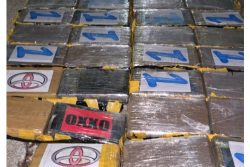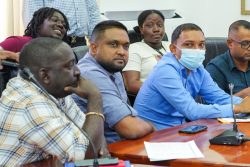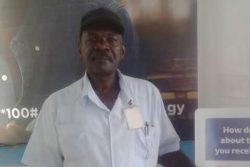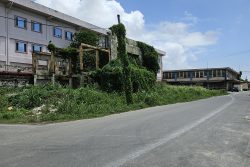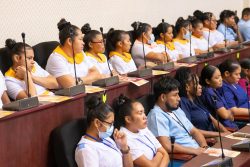Minister of Communities Ronald Bulkan has disclosed that Polyhexanide, also known as Antinfek, has been used in the past by the Guyana Water Inc (GWI) for the purification of water supply lines in limited areas.
Bulkan made the disclosure in the National Assembly last Friday during questioning by PPP/C parliamentarian Dr. Frank Anthony, however, he was unable to ascertain from the minister specifically where and when as he had exceeded the number of follow-up questions permitted.
The use of the chemical by GWI is currently under scrutiny as despite the company’s claims that it is only being tested, leaked emails indicate that the chemical was being used in wells at Bartica, Diamond and Hillfoot on the Linden-Soesdyke Highway.
Anthony implored Bulkan to answer several question on the matter, including whether Antinfek was indeed being used in place of chlorine at GWI treatment plants, who authorised its use, when the decision was taken to use the chemical as a replacement for chlorine, the locations where this is being done and the population size where the chemical was being used. He also sought to ascertain which international agencies have certified its use, possible side effects linked to prolonged consumption of the chemical and if so, what, and if any surveillance system is in place to monitor side-effects.
Bulkan was also asked to comment on the system of procurement used by the GWI to purchase Antinfek, including who was awarded the contract for the supply of the chemical and at what cost.
In response to the barrage of questions, Bulkan noted that he had only learned of the opposition’s intention to “ambush” him with the question a mere two hours prior to the commencement of the sitting of the National Assembly and therefore he was not in a position to give full and complete answers.
As a result, he opted to provide the House with what he said would be “preliminary answers.”
He went on to note that in light of the reports that would have been circulated in the media relative to Antinfek being used in place of chlorine for water purification purposes, the Public Utilities Commission (PUC) had written to GWI seeking clarification, while registering its concerns.
In fact, the PUC, in a letter, dated October 17, 2016 and addressed to Chief Executive Officer of the corporation Dr. Richard Van West-Charles and copied to Bulkan, noted reports in the media that “GWI is using Polyhexanide in the water treatment which may pose a risk to consumers” and instructed that if true the company should “immediately cease the use of the chemical until a full and comprehensive review by an external agency confirms that it is compatible with existing safety standards.”
Bulkan told the House that the GWI management team had met with the PUC, where complete answers were provided to the queries and concerns posed by the PUC.
He maintained that Antinfek was not being used to replace chlorine in the purification of water by GWI.
“I’d like to assure the Honourable Member that the particular chemical has not been used at any of the locations for which treated water is provided by GWI; at all of the locations, it is a case that chlorine is the sole disinfectant that is being used,” Bulkan said, while acknowledging that it is common knowledge that GWI would have also implemented the use of Lye and Alum in some treatment plants.
Further, he emphasised that there has not been a reduction in the orders made for the procurement of chlorine relative to the purification of water by GWI as it remains the sole purifying agent used by the company.
However, his response did not satisfy Anthony, who continued to press the minister to explain how much of the chemical was procured and for what purpose.
At that point, Bulkan said Antinfek was used in Guyana prior to its current consideration by GWI and that approval had been given by the Pesticides and Toxic Chemical Controls Board. Further, he pointed out that a total of 100 litres of the chemical had been procured and was being used for testing purposes.
Yet again, the minister’s response did not satisfy Anthony, who implored him to state where the chemical was being used. In response, Bulkan disclosed that Antinfek had been previously used by GWI to clean water supply pipes in limited locations.
Although Anthony made additional attempts to seek clarity on the matter of the chemical being used for clearing water supply lines, he was barred from asking further questions by Speaker Barton Scotland, who pointed out that he had exceeded the two allotted follow-up questions.
GA-FDD
The Guyana Analyst-Food and Drug Department (GA-FDD) has raised concerns about Antinfek and whether the appropriate permissions were sought by GWI.
Stabroek News has seen documentation from GWI meetings that indicates that the chemical was being used in wells at Bartica, Diamond and Hillfoot, Linden-Soesdyke Highway and that $3.6 million had already been paid to the local subsidiary of the Thailand-based company, Dove Biotech, which was selected in a single source process to supply the chemical.
At an April 11 meeting, it was indicated that an Antinfek 10H chemical order was expected the next day and Van West-Charles suggested that a guideline for chemical dosing in hinterland and riverain communities be prepared. At another meeting, dated June 7, it was stated that the “two dosing pumps” to monitor the chemical were procured for Hill Foot and Mabaruma.
At a July 6 meeting, it was stated that three of the five wells in Region Nine-Tabatinga, Bon Success and Kanuku-were contaminated with fecal and total coliforms and that since the network was interconnected the entire network is affected. It was at that meeting the Director of Operations recommended that a “small amount of the Antinfek chemical can be used to shock chlorinate the wells.”
On July 11, the Director of Operations reported at a meeting that the Diamond Well was functioning fine and that the well “is being dosed with Antinfek 10H chemical to treat the water.” However, on August 11 the same official said that he had ceased using the chemical to treat the water at Diamond since he was informed by the Water Quality Manager Donna Canterbury that the corporation’s laboratory could not test Antinfek when it is being used.
At this stage, the corporation was aware that the chemical’s safety for human use was questionable and that its own equipment to monitor the residuals was obsolete.
Stabroek News has also seen email correspondence between Director of the Government Analyst-Food and Drug Department Marlan Cole, GWI Chemical Engineer Deon Anderson and representatives of the Pan American Health Organization (PAHO) and the World Health Organization (WHO), which questioned the proposed use of the chemical.
Cole, who claimed he was disturbed after he read in the Guyana Times that GWI had stopped using chlorine to treat water and was instead using Antinfek, had questioned the decision to replace chlorine with the controversial Antinfek. “They didn’t even say let us do a pilot…over the years we used chlorine and that has been effective. I don’t know who ordered this and under what basis but this is very disturbing and I will have to get to the bottom of it… This is serious. We all use this water and we don’t know what it is being treated with?” he questioned.
At that time, Stabroek News was informed that Cole had been in communication with GWI with a view to clarifying exactly what chemical is being used for purification but it is unclear whether he has received a response.
However, GWI in a press statement the following day said that Cole’s statements “were inaccurate and irresponsible as a senior government functionary. Instead of contacting GWI to gain clarity on the thinking behind the use of Antinfek and whether or not chlorine was still being used, Mr Cole added to an unnecessary cause for public alarm.”
Claiming that Antinfek is not harmful for human consumption, GWI maintained that chlorine is being used as the sole disinfecting agent in all treatment plants, while “laboratory studies are being done on the use of other treatment alternatives.”
Before Anderson had reached out to Cole and the international experts, Canterbury had already expressed concerns about Antinfek and recommended that it not be used. Her recommendation was in keeping with the same one she made in 2012, when the company had approached GWI.
According to documentation seen by this newspaper, while Canterbury would have conducted tests on the chemical in 2012 which proved positive, she did not recommend its use as the supplier could not have provided her with the side effects of the Antinfek 10H. At the time, GWI did not have the equipment to test for the chemical and confirm the correct dosage and PAHO could not have confirmed that the chemical should be used in water.

